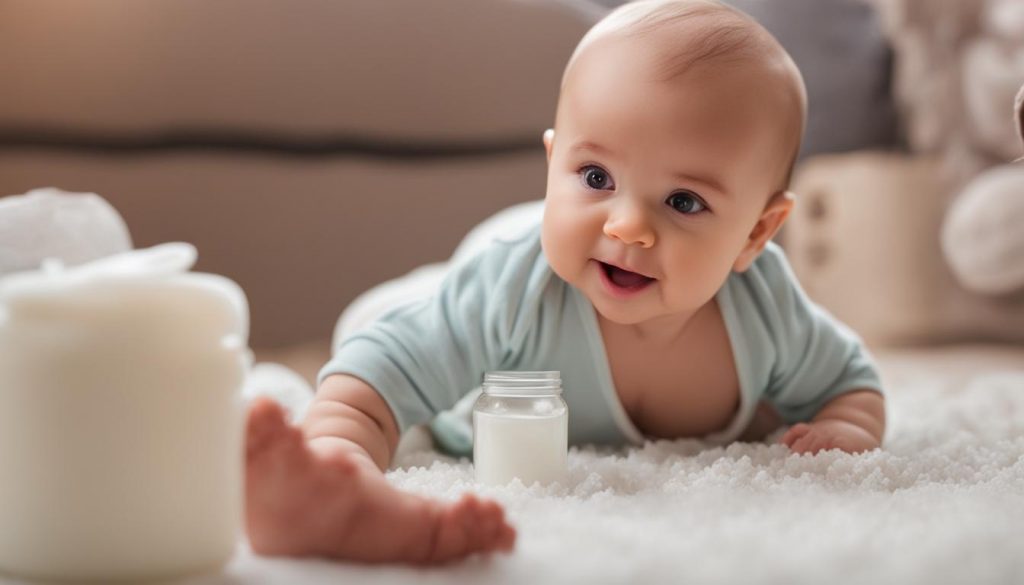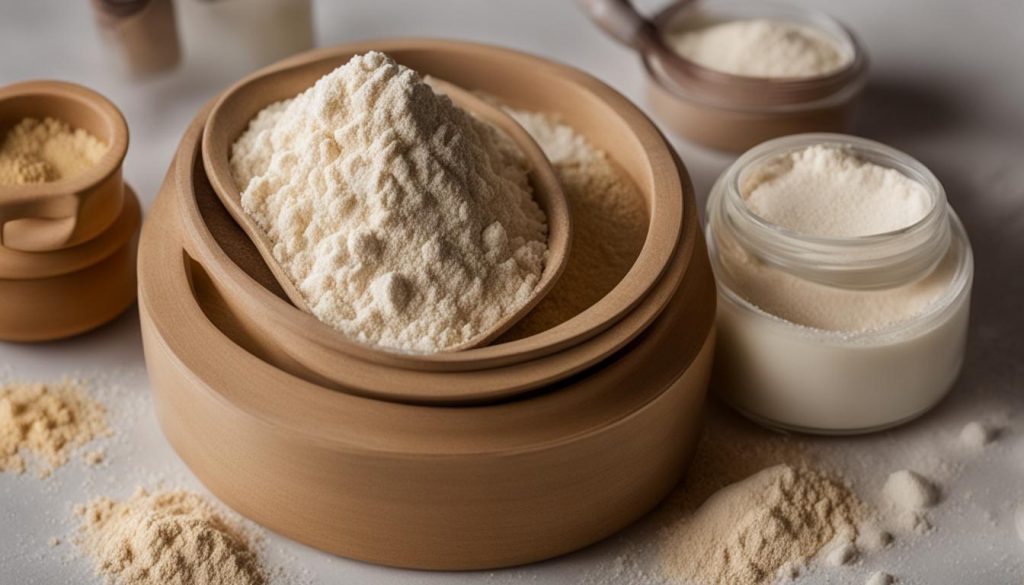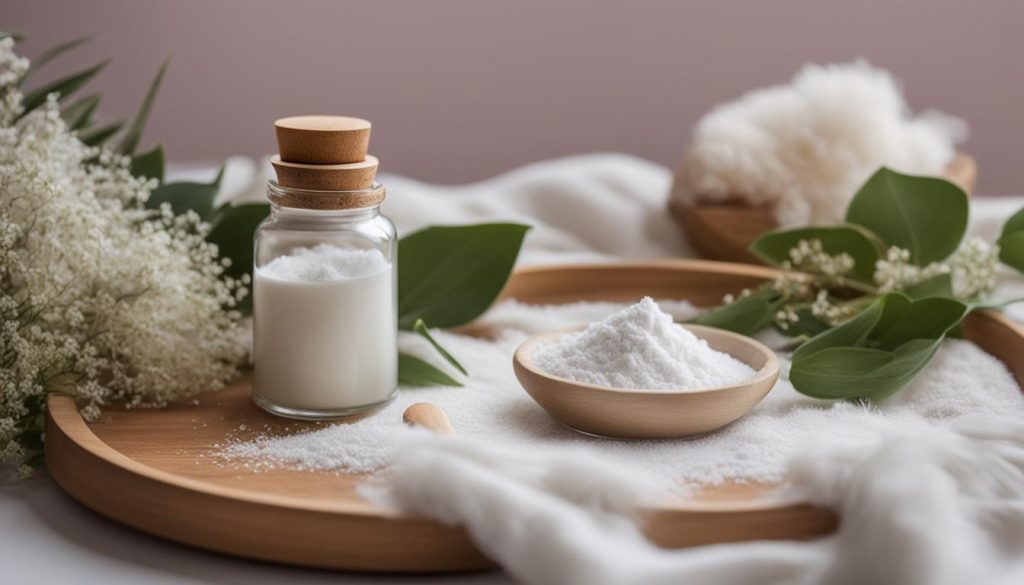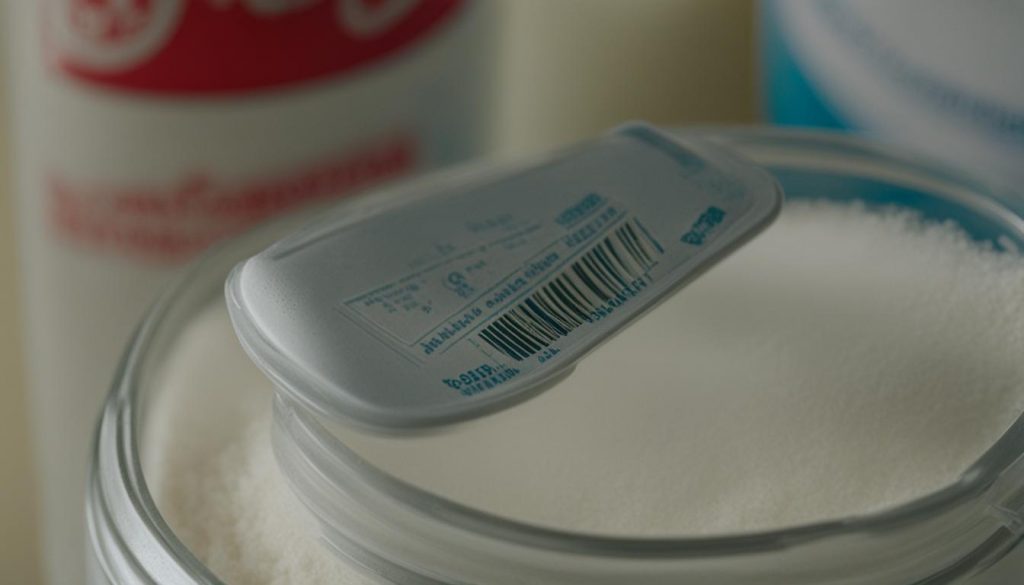Diaper rash is a common discomfort experienced by many infants. While the use of baby powder has long been believed to be helpful for diaper rash, there is a need to understand the appropriate use and potential risks. Let’s explore effective remedies and preventive care for your baby’s comfort and health.
Key Takeaways:
- Diaper rash is a common discomfort experienced by infants.
- Baby powder has limited scientific evidence for treating diaper rash.
- Preventive measures such as frequent diaper changes and proper hygiene can help reduce the risk of diaper rash.
- Opt for hypoallergenic alternatives to baby powder for sensitive skin or allergies.
- Consult with healthcare professionals for personalized advice and treatment options.
Understanding Diaper Rash: Causes, Symptoms, and Treatment
Diaper rash, also known as irritant diaper dermatitis, is a common condition that affects infants. It is characterized by redness, irritation, and discomfort in the diaper area. Understanding the causes, symptoms, and treatment options for diaper rash is essential for providing relief to your baby and promoting their overall well-being.
There are several factors that can contribute to the development of diaper rash. These include dirty diapers, excessive moisture, chafing, changes in diet, sensitive skin, and bacterial or yeast infections. It is important to identify the underlying cause of your baby’s rash to effectively treat it.
Treatment for diaper rash focuses on keeping the diaper area clean and dry. This can be achieved by frequently changing diapers, using gentle baby wipes or warm water and mild soap for cleansing, and ensuring proper airflow to the area. Applying barrier creams or ointments with safe ingredients like zinc oxide or petroleum jelly can also provide relief and protection for your baby’s delicate skin.
Common Symptoms of Diaper Rash:
- Redness and inflammation in the diaper area
- Irritation and discomfort
- Small bumps or pimples
- Fluid-filled blisters
- Pain or tenderness
It is important to note that if your baby’s rash does not improve with home remedies or if it worsens, it is recommended to consult a healthcare professional. They can provide a proper diagnosis and suggest additional treatment options if necessary.
| Causes | Symptoms | Treatment |
|---|---|---|
| Dirty diapers | Redness and inflammation | Frequent diaper changes |
| Excessive moisture | Irritation and discomfort | Keep diaper area dry |
| Chafing | Small bumps or pimples | Use gentle cleansing products |
| Changes in diet | Fluid-filled blisters | Apply barrier creams or ointments |
| Sensitive skin | Pain or tenderness | Ensure proper airflow |
| Bacterial or yeast infections |
The Role of Baby Powder in Diaper Rash
Baby powder has long been a go-to solution for many parents when it comes to managing diaper rash. It is believed to help keep the diaper area dry and reduce friction, providing relief to the baby’s sensitive skin. However, it is crucial to understand that the use of baby powder for diaper rash is not supported by extensive scientific evidence.
Talcum powder, a common ingredient in baby powder, has been linked to respiratory and dermatological risks in infants. In fact, the American Academy of Pediatrics advises against the use of talcum powder on infants, as it can potentially lead to respiratory problems if inhaled and cause skin irritation. It is important to prioritize the safety and well-being of your little one by opting for alternative options for soothing and preventing diaper rash.
Instead of relying on baby powder, there are several effective remedies and preventive measures that can be utilized. These include frequent diaper changes, gentle cleansing with warm water and mild soap, using fragrance-free and alcohol-free wipes, air-drying the diaper area, and applying barrier creams or ointments with safe ingredients like zinc oxide or petroleum jelly. These measures can help keep your baby’s skin dry, protect it from irritants, and promote the healing of diaper rash.
| Pros of Baby Powder for Diaper Rash | Cons of Baby Powder for Diaper Rash |
|---|---|
| May help reduce friction and keep the diaper area dry | Potential respiratory risks if inhaled |
| Traditional remedy that some parents find effective | Can cause skin irritation and worsen existing rash |
It is essential to consult with a healthcare professional for personalized advice on managing diaper rash and determining the best course of action for your baby’s specific needs. Remember, every baby is unique, and what works for one may not work for another. By prioritizing safety and utilizing evidence-based remedies, you can effectively address diaper rash and provide your baby with the comfort they deserve.
Effective Remedies for Diaper Rash Relief
When it comes to soothing and preventing diaper rash, there are several natural remedies and preventive measures that can be effective in providing relief for your baby. By following these tips, you can help keep your baby’s delicate skin comfortable and healthy.
Diaper Rash Prevention Tips:
- Change diapers frequently: Regular diaper changes are essential to keep your baby’s skin dry and clean. This helps to prevent the buildup of moisture and bacteria that can contribute to diaper rash.
- Gentle cleansing: Use warm water and mild soap to clean your baby’s diaper area during each diaper change. Avoid using harsh wipes or products that may further irritate the skin.
- Fragrance-free and alcohol-free wipes: Opt for gentle baby wipes that are free from fragrances and alcohol, as these ingredients can be harsh on your baby’s skin and may exacerbate diaper rash.
- Air-drying: Allow your baby’s diaper area to air-dry for a few minutes before putting on a fresh diaper. This helps to keep the skin dry and promotes healing.
In addition to these preventive measures, there are also specific treatments that can help soothe and heal diaper rash:
- Barrier creams or ointments: Apply a thin layer of a barrier cream or ointment with safe ingredients like zinc oxide or petroleum jelly to protect your baby’s skin from further irritation and promote healing.
- Natural remedies: Some natural remedies, such as coconut oil or calendula cream, can provide soothing relief for diaper rash. These remedies have anti-inflammatory and antimicrobial properties that help to reduce redness and inflammation.
- Increased airflow: Choose diapers that allow for increased airflow to the diaper area, such as breathable cloth diapers or those with breathable panels. This helps to keep the skin dry and prevents moisture buildup.
By implementing these effective remedies and preventive measures, you can provide relief for your baby’s diaper rash and promote their overall comfort and well-being. Remember to consult with a healthcare professional for personalized advice and treatment options tailored to your baby’s specific needs. Each baby is unique, and what works for one may not work for another.
Hypoallergenic Alternatives to Baby Powder for Sensitive Skin
For babies with sensitive skin or allergies, it is important to explore hypoallergenic alternatives to traditional baby powder. These alternatives are specifically formulated to soothe and protect the delicate diaper area without causing irritation or allergic reactions. By opting for these safer options, you can ensure your baby’s comfort and promote healthy skin.
Choosing Natural Cornstarch-Based Powders
A great alternative to baby powder is natural cornstarch-based powders. These powders are derived from cornstarch, making them gentle and hypoallergenic. Cornstarch is known for its absorbent properties, which can help keep the diaper area dry and prevent irritation. Look for products that are free from added fragrances, talcum powder, and other potential irritants.
“Natural cornstarch-based powders are a safer option for babies with sensitive skin or allergies.”
Exploring Creams and Ointments
In addition to powders, there are also hypoallergenic creams and ointments available specifically for diaper rash relief. These products are often made with gentle, soothing ingredients like zinc oxide or petroleum jelly. They create a protective barrier on the skin, reducing friction and allowing the diaper area to heal. When choosing a cream or ointment, make sure to check the ingredients and choose a product that is free from irritants.
Consulting with a Healthcare Professional
Every baby’s skin is unique, and what works for one may not work for another. If you have concerns about your baby’s skin or are unsure about which hypoallergenic alternative to choose, it is always best to consult with a healthcare professional. They can provide personalized advice based on your baby’s specific needs and help you find the most suitable product for their sensitive skin.
| Hypoallergenic Alternatives | Benefits |
|---|---|
| Natural Cornstarch-Based Powders | – Gentle and hypoallergenic – Absorbent and keeps the diaper area dry – Free from added fragrances and irritants |
| Creams and Ointments | – Creates a protective barrier on the skin – Reduces friction and allows healing – Made with soothing ingredients like zinc oxide or petroleum jelly |
By exploring hypoallergenic alternatives to baby powder, you can provide your baby with the relief they need without risking irritation or allergic reactions. Whether it’s natural cornstarch-based powders or creams and ointments, prioritize your baby’s sensitive skin and consult with a healthcare professional for personalized recommendations.
Expert Opinions and Pediatric Recommendations
When it comes to addressing diaper rash in infants, it is important to seek advice from experts in the field of pediatrics. Leading pediatric organizations such as the American Academy of Pediatrics and Mayo Clinic hold valuable recommendations for parents and caregivers, helping to ensure the well-being and comfort of their little ones.
According to experts, the use of baby powder for diaper rash is not recommended. These organizations caution against the use of talcum powder, a common ingredient in baby powder, due to potential respiratory and dermatological risks for infants. Instead, they emphasize the importance of maintaining good hygiene practices and using barrier creams or ointments with safe ingredients.
“The use of baby powder, particularly those containing talcum powder, should be avoided for diaper rash. Focus on frequent diaper changes, proper cleansing, and the use of barrier creams with safe ingredients.” – American Academy of Pediatrics
Healthcare professionals, such as pediatricians and nurses, can provide personalized advice and treatment options for managing diaper rash based on the specific needs of each baby. Consulting with a healthcare professional is crucial for appropriate care and to address any concerns or questions parents may have regarding diaper rash and the use of baby powder.
Expert Recommendations for Diaper Rash:
- Avoid using baby powder, especially those containing talcum powder.
- Focus on regular diaper changes to keep the diaper area clean and dry.
- Use gentle cleansing products, such as fragrance-free and alcohol-free wipes.
- Apply barrier creams or ointments with safe ingredients like zinc oxide or petroleum jelly.
By following expert opinions and pediatric recommendations, parents and caregivers can ensure the comfort and well-being of their baby while effectively managing and preventing diaper rash.
Safety and Application of Baby Powder
When it comes to using baby powder, especially in the context of diaper rash, safety should always be the top priority. While there are certain guidelines for safe application, it is important to note that baby powder should not be used as a treatment for diaper rash. Let’s explore the dos and don’ts of applying baby powder, keeping in mind the well-being of your little one.
Do:
- Apply the powder away from the face to prevent inhalation.
- Ensure that the baby powder is kept out of reach of children to avoid accidental ingestion.
- Use a gentle and controlled motion when applying the powder to prevent excessive inhalation or scattering.
- Follow the manufacturer’s instructions for usage and storage of the baby powder.
Don’t:
- Apply the powder directly to your baby’s diaper rash. Baby powder is not a recommended treatment for diaper rash and may exacerbate the condition.
- Use baby powder containing talcum powder. Talcum powder has been associated with potential respiratory and dermatological risks in infants.
- Overuse baby powder. Excessive application of baby powder can be harmful to your baby’s health.
As a parent, it is crucial to prioritize the safety and well-being of your baby. While baby powder can have certain uses, it should not be relied upon as a solution for diaper rash. It is always best to consult with a healthcare professional for personalized advice and treatment options.
Table: Comparing Baby Powder Alternatives for Diaper Rash
| Product | Ingredients | Benefits |
|---|---|---|
| Natural Cornstarch-based Powders | Cornstarch, natural ingredients | Gentle, soothing, and safe for sensitive skin |
| Hypoallergenic Creams | Specialized hypoallergenic ingredients | Soothes and protects the diaper area, reduces the risk of irritation and allergies |
| Zinc Oxide Creams | Zinc oxide, natural ingredients | Forms a protective barrier, helps heal and prevent diaper rash |
When searching for alternatives to baby powder, consider these options that are specifically formulated to be gentle and effective for diaper rash relief. Each product has its own unique benefits, so choose the one that best suits your baby’s needs and consult with a healthcare professional if you have any concerns.
Importance of Proper Diaper Care for Preventing Diaper Rash

Proper diaper care plays a crucial role in preventing diaper rash and ensuring your baby’s comfort. By following a few simple tips and guidelines, you can significantly reduce the risk of diaper rash and maintain your baby’s delicate skin in a healthy condition.
Regular Diaper Changes
One of the most important steps in preventing diaper rash is to change your baby’s diaper regularly. Wet or soiled diapers should be promptly removed and replaced with a clean one. This helps to minimize moisture and reduce the chances of irritation and infection. Aim for frequent diaper changes, especially after bowel movements, to keep your baby’s diaper area clean and dry.
Proper Hygiene
Cleanliness is vital when it comes to preventing diaper rash. Use warm water and a mild soap or baby wipe to gently cleanse your baby’s diaper area during each diaper change. Avoid using wipes that contain alcohol or fragrances as they can cause irritation. Pat the area dry with a soft towel or allow it to air-dry before putting on a fresh diaper.
Use of Barrier Creams or Ointments
Applying a barrier cream or ointment can help protect your baby’s skin from moisture and friction. Look for products that contain safe ingredients like zinc oxide or petroleum jelly. These create a protective barrier on the skin surface, preventing contact with irritants and reducing the risk of diaper rash. Remember to apply a thin layer of the barrier cream or ointment during each diaper change.
By implementing these diaper rash prevention tips, you can keep your baby’s diaper area healthy and free from discomfort. Remember that every baby is unique, and it may take some trial and error to find the best routine and products that work for your little one. If you have any concerns or if your baby develops a persistent or severe diaper rash, consult with a healthcare professional for personalized advice and treatment options.
Recommendations for Soothing and Preventing Diaper Rash
When it comes to ensuring your baby’s comfort and preventing diaper rash, there are a few key recommendations to keep in mind. It is important to avoid using baby powder, as it can pose risks to your baby’s respiratory and dermatological health. Instead, opt for safe alternatives such as barrier creams or ointments with ingredients like zinc oxide or petroleum jelly. Here are some additional tips:
Diaper Rash Prevention Tips:
- Change diapers frequently: Regularly changing dirty diapers can help keep your baby’s skin clean and dry, reducing the risk of diaper rash.
- Gentle cleansing: Use warm water and mild soap or fragrance-free, alcohol-free wipes to clean your baby’s diaper area. Avoid harsh soaps or wipes with irritating ingredients.
- Air-drying: After cleaning, allow your baby’s diaper area to air-dry completely before putting on a fresh diaper. This can help minimize moisture and promote healing.
- Choose breathable diapers: Opt for diapers that allow for increased airflow, as excessive moisture can contribute to diaper rash. Look for diapers made with breathable materials.
- Avoid tight-fitting diapers and clothes: Clothing that is too tight can cause friction and irritation, increasing the risk of diaper rash. Choose loose-fitting, breathable clothes for your baby.
By following these preventive measures and avoiding the use of baby powder, you can help soothe and protect your baby’s delicate skin. It is always a good idea to consult with a healthcare professional for personalized advice and guidance on managing and preventing diaper rash.
Comparison of Baby Powders for Diaper Rash:
| Brand | Ingredients | Key Features |
|---|---|---|
| Brand A | Cornstarch, Aloe Vera | Hypoallergenic, soothing properties |
| Brand B | Talc-free, Lavender extract | Gentle, calming fragrance |
| Brand C | Cornstarch, Chamomile | Natural, anti-inflammatory properties |
Note: Always read the product labels and consult with your healthcare provider before using baby powders for diaper rash. Each baby may have different sensitivities and preferences, so it’s important to find the right product for your little one.
Conclusion
In conclusion, effectively managing diaper rash requires the right care and preventive measures. It is crucial to avoid using baby powder for diaper rash relief. Instead, focus on frequent diaper changes to keep the diaper area clean and dry. Gentle cleansing with warm water and mild soap can help soothe the skin.
Using appropriate barrier creams or ointments, such as those containing zinc oxide or petroleum jelly, can provide relief and protection for your baby’s delicate skin. Remember to consult with healthcare professionals for personalized advice and treatment options, as every baby is unique and what works for one may not work for another.
By prioritizing your baby’s comfort and following recommended practices, you can effectively treat and prevent diaper rash. Remember, the key is to maintain proper hygiene and provide gentle care to ensure your baby’s skin remains healthy and rash-free.
FAQ
Does baby powder help with diaper rash?
Baby powder has limited scientific evidence to support its effectiveness in treating diaper rash. It is recommended to seek alternative options for soothing and preventing diaper rash.
What are the causes, symptoms, and treatment of diaper rash?
Diaper rash can be caused by factors such as dirty diapers, excessive moisture, chafing, diet changes, sensitive skin, bacteria, or yeast infections. It is characterized by redness and irritation in the diaper area. Treatment options include keeping the diaper area clean and dry, using gentle baby wipes, and applying barrier creams or ointments.
What is the role of baby powder in diaper rash?
Baby powder has traditionally been used to keep the diaper area dry and reduce friction. However, there is limited scientific evidence to support its effectiveness in treating diaper rash. Talcum powder, a common ingredient in baby powder, can pose risks to infants and should be avoided.
What are effective remedies for diaper rash relief?
Effective remedies include frequent diaper changes, gentle cleansing with warm water and mild soap, using fragrance-free and alcohol-free wipes, air-drying the diaper area, and applying barrier creams or ointments with safe ingredients like zinc oxide or petroleum jelly.
Are there hypoallergenic alternatives to baby powder for sensitive skin?
Yes, hypoallergenic alternatives such as natural cornstarch-based powders or creams specifically formulated to soothe and protect the diaper area without causing irritation or allergic reactions are available.
What do experts and pediatric organizations recommend regarding baby powder and diaper rash?
Pediatric experts and organizations advise against using baby powder for diaper rash. They recommend focusing on regular diaper changes, proper hygiene, and the use of barrier creams or ointments with safe ingredients. It is important to consult with a healthcare professional for personalized advice.
What are the dos and don’ts for baby powder application?
It is important to apply baby powder away from the face, keep it out of the reach of children, and avoid direct inhalation. However, baby powder should not be used as a treatment for diaper rash.
How important is proper diaper care for preventing diaper rash?
Proper diaper care, including frequent diaper changes, keeping the diaper area clean and dry, using gentle cleansing products, and using appropriate barrier creams or ointments, is crucial for preventing diaper rash.
What are the recommendations for soothing and preventing diaper rash?
Recommendations include using barrier creams or ointments with safe ingredients, following diaper rash prevention tips such as frequent diaper changes and proper hygiene, and using diapers that promote airflow. Consult with healthcare professionals for personalized advice.
What is the summary and conclusion regarding diaper rash relief?
Diaper rash can be effectively managed by avoiding the use of baby powder and opting for safe and proven remedies. Prioritize your baby’s comfort and consult with healthcare professionals for personalized advice and treatment options.





